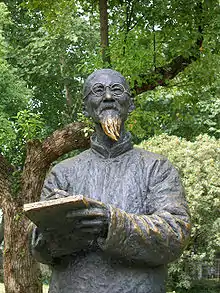Huang Binhong
Huáng Bīnhóng (Chinese: 黃賓虹; 1865–1955) was a Chinese literati painter and art historian born in Jinhua, Zhejiang province. His ancestral home was She County, Anhui province.[1] He was the grandson of artist Huang Fengliu. He would later be associated with Shanghai and finally Hangzhou. He is considered one of the last innovators in the literati style of painting and is noted for his freehand landscapes.
His early painting style showed the influence of Li Liufang (李流芳), Cheng Sui, Cheng Zhengkui, Kun Can, Hong Ren and the Yuan and Ming masters. It emphasized on the importance of the unification of positive and negative space; dark and light shades. Each brush line is powerful and precise. The compact touches, the graceful outlines and the elegant styles of Xin’an School of painting (新安画派) had a profound influence on Huang throughout his life. His style before the age of sixty is called the White-period.[2]
After sixty years old, Huang went to Guichi. The scenery of Guichi not only attracted the artist, but also had a great impact on his style. Huang changed from focusing on brush and line to focusing on ink and wash. He started to practice the painting style of Wu Zhen. In 1928, Huang visited Guangxi and Guangdong and created a lot of works by sketching the real landscapes. Huang started to transit from his “White style” to “Black style”.[3]
At the age of sixty nine to seventy, Huang visited Sichuan. He was inspired by the atmosphere of Mount Qingcheng in rain and the Qutang Gorge under moonlight. He utilized dripping, staining and layers of dense ink to illustrate the misty wet feeling of rain and the nightly view of mountains. Since then, his "black, dense, thick, heavy" style became his significant feature.[4]
From 1937 to 1948, Huang lived in Beijing for eleven years and most of his Black period paintings were done during that time. After that, he moved to Hangzhou and started another new horizon in his art. Inspired by Western Impressionism, he integrated the two major Chinese painting systems (Ink and wash painting and color painting) into a unity. Dots of red, green and blue pigment merged with layers of dense ink creating a luxuriant and richly integrated style in which he deftly manipulated solid and void. His varied style and creativity not only won him an honorary title, but also brought light into the modern Chinese art history.[5]
He also had significance for creating several societies devoted to painting and calligraphy.
References
- Cihai: Page 2056.
- Wen, Guanghua (文光华) 中国文化风采录·徽州文化 [Chinese culture and history · Huizhou culture] (2010) ISBN 9787894522504
- Wen, Guanghua (文光华) 中国文化风采录·徽州文化 [Chinese culture and history · Huizhou culture] (2010) ISBN 9787894522504
- Wen, Guanghua (文光华) 中国文化风采录·徽州文化 [Chinese culture and history · Huizhou culture] (2010) ISBN 9787894522504
- Zheng, Chenghang (郑成航) https://news.artron.net/20170330/n919987.html “内美静参——黄宾虹山水画展”浙江美术馆开幕 [Huang Binhing Landscape painting exhibition at Zhejiang Art Museum] (2017)
